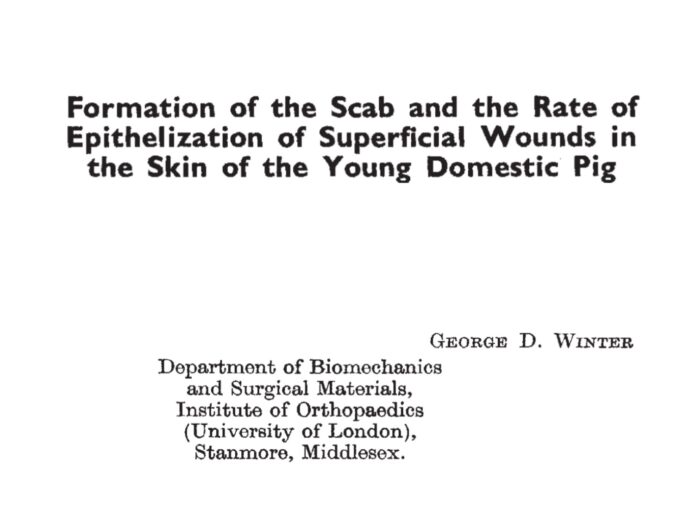We are going to analyse probably the most referenced article about wound healing, but probably also the least read.

In fact, in any scientific text that talks about “moist wound healing” in chronic ulcers, you find the reference “Winter GD. Formation of the scab and the rate of epithelization of superficial wounds in the skin of the young domestic pig. Nature. 1962 Jan 20;193:293-4″.
It seems to be universally accepted that this article by George Winter marks a “before and after” in the world of wound healing… If until then it was thought that the best thing to do was to dry the wounds, following this study “moist wound healing” began to be talked about as the cornerstone of modern wound treatment and, in parallel, the boom in dressings.
If you haven’t read this very famous (and very short) article, you might be surprised by these details of its methodology and results, as well as Winter’s actual conclusions. Here we go:
- It’s an experimental study with pigs, young and healthy. It is not clear how many pigs were included, but it only mentions two.
- Wounds were created on the back up to the papillary dermis, i.e. clean superficial surgical wounds.
- The area where the wounds were made had been waxed beforehand.
- To compare the estimated epithelialisation rate between wounds covered with a polyurethane film (“moist wounds”) and uncovered (open air) wounds, serial skin biopsies were performed.
- Each pig was used as its own control. Twelve wounds were studied (6 in each group).
- In the results the author highlights that, at day 3, the amount of new epidermis (observed under the microscope) was twice as high in the “moist” wounds as in the uncovered ones, i.e. a higher rate of epithelialisation. However, although it does not say so in the text, the table in the article shows that from day 7 onwards there is no difference in the rate of epithelialisation.
- He also suggests a faster formation of connective tissue in “moist” wounds, but the article does not provide any data to support this.
- Winter concludes that “the demonstration that a simple change in physical conditions at the wound surface can have such a marked effect on the rate of epithelialisation is highly relevant to experimental methods in wound healing. It would be imprudent to draw conclusions about the specific effects of different products on the rate of healing”.
Were you surprised? Well, this article with 12 acute superficial wounds in pigs is the starting point of the spiral of generalisation of the “moist environment” in chronic wounds…
I would like to point out that in the discussion of his article Winter mentions the role of the scab in preventing the entry of dirt and microorganisms, as well as protecting the newly formed epidermis from dehydration. In our practice we perform daily wounds with the same characteristics as in Winter’s study, down to the papillary dermis, to obtain punch grafts… And 60 years after this article no dressing has been shown to be superior to the rest, or even to scabs, in clean superficial acute wounds! See entries: “Which dressing should I choose to cover the skin graft donor site?” and “Tricks to avoid complications in acute wounds”.
As you already know, what I like to talk about is “optimal environment”… Which is still not clear what it is… So I am going to finish by mentioning an article that, contrary to Winter’s, is very little referenced… The author makes a very interesting reflection, which I cannot share more:
“Since we have been using scabs as wound coverings for thousands of years, we should try to improve their performance, instead of ignoring the benefits of this very effective dressing” Nelson EA. Moist wound healing: critique II. J Wound Care. 1995 Sep 2;4(8):370-371.
In fact, when I read this reflection, my first thought was: “Wow… And I thought this sentence was mine ;)”.




